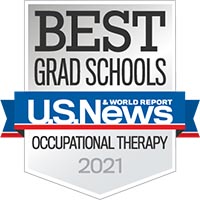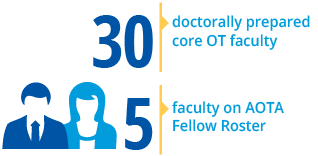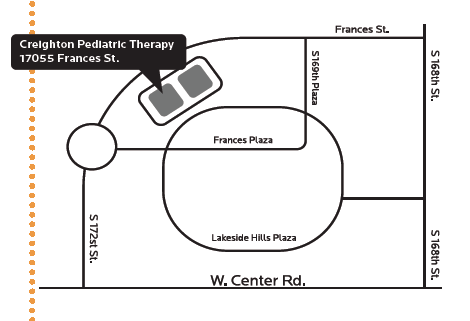History
OCCUPATIONAL THERAPY: HELPING OTHERS LIVE MEANINGFUL LIVES.

Positively impact people’s health and well-being through the engagement of occupations that fill their lives.
 In the Creighton University School of Pharmacy and Health Professions occupational therapy program, you will gain experience intervening when illness, disability or social constraints threaten an individual’s ability to create or find balance in their environment.
In the Creighton University School of Pharmacy and Health Professions occupational therapy program, you will gain experience intervening when illness, disability or social constraints threaten an individual’s ability to create or find balance in their environment.
The program blends knowledge from the physical and social sciences into a unique, distinct and holistic occupational therapy profession.
Occupational Therapy learning and formation in a variety of settings
In our occupational therapy program, you will focus on how the body, mind and spirit work together to produce occupations as simple as feeding oneself or as complex as leading a hundred-piece orchestra.
orchestra.
Our education program includes coursework and fieldwork in a variety of settings, including hospitals, clinics, school systems and community centers. You will benefit from both didactic and experiential learning and from faculty mentors dedicated to empowering your ability to find a clinical experience trajectory that fits your goals.
Our occupational therapy program is designed to be rigorous, comprehensive, and meet accreditation standards in order to prepare our students for successful outcomes with examination board completion. Learn more about program curriculum, schedules and dates.
We offer a program that emphasizes the value of what it means to be an occupational therapy professional that focuses on caring for the whole person and bringing value to all patients’ lives. Watch this video to learn what it means to be an occupational therapist from Creighton University.
![]() Recommended Student Dress Code.pdf
Recommended Student Dress Code.pdf
Born in Ohio in 1820, Edward Creighton was a successful businessman before he moved to Omaha in 1856.
Edward’s diverse business interests included cattle ranching, banking and freight operations. He also played a major role in developing the transcontinental telegraph line.
When he died in November 1874, his fortune passed to his wife, Mary Lucretia Creighton.
![]() aa-CPT Registration Packet for Web Site_0.pdf
aa-CPT Registration Packet for Web Site_0.pdf
Mary Lucretia Creighton (b. 1834) married Edward Creighton in 1856. The newlyweds settled in Omaha, where Edward had recently relocated his business.
Known for her charitable work, Mary personally delivered food, money and other items to needy Omaha families.
After her death in 1876, Mary’s will provided $100,000 as a memorial to her late husband “to purchase the site for a school in the city of Omaha and erect buildings thereon for a school of the class and grade of a college.”
 Bishop James O’Connor took on the task of starting the school Mary envisioned. He enlisted the Society of Jesus to operate Creighton University.
Bishop James O’Connor took on the task of starting the school Mary envisioned. He enlisted the Society of Jesus to operate Creighton University.
Since Roman Shaffel, S.J., led five Jesuits (and two lay teachers) to open the school in September 1878, Creighton has been home to hundreds of Jesuits.
Currently, dozens of Jesuits administrate, teach and provide ministry at the University.
Visit our community on campus.
John A. Creighton, Edward’s younger brother, was born in 1831 in Ohio.
He came to Nebraska in 1856 to work for his brother. He later found success in gold mining in Montana.
In 1868, Edward married Sarah Emily Wareham (b. 1840), a younger sister of Mary Lucretia Creighton.
He emerged as a leading figure in the Omaha community — he was one of the organizers of the Omaha stockyards — with business interests across several states.
In 1895, Pope Leo XIII named John Creighton a Knight of the Holy Roman Empire for his philanthropic support of Creighton University and other Catholic works.
Campus and the Colleges

In 1878, the College of Arts and Sciences was established and is still the largest division at Creighton. The college was housed in the University’s original building, Creighton Hall (formerly known as the Administration Building).
In 1930, an expansion added the distinctive art deco limestone façade of the building’s main entrance.
Many Jesuits live in Creighton Hall, which also houses classrooms and several offices, including the Office of the President.
![]() application-CPT-Therapist_2015.docx
application-CPT-Therapist_2015.docx
The first part of the Creighton Observatory, a brick roundhouse with a revolving dome, was constructed in 1886, while the rectangular transit room was finished the following year.
The building received a makeover in 1910, when the extension of 24th Street cut away part of the hill.
Sarah Emily Creighton’s desire for students to have a proper place to worship resulted in the construction of St. John’s Collegiate Chapel, dedicated May 6, 1888.
The creation of St. John’s Parish in 1897 meant that the church could conduct baptisms, weddings and funerals.
A series of expansions between 1920 and 1922 doubled the church’s capacity. In 1977, the east tower received a steeple and hands for its clock.

With the establishment of the John A. Creighton Medical College in 1892, Creighton became a university in the true sense of the word.
The medical school was affiliated with the new Creighton Memorial St. Joseph’s Hospital, named for Sarah Emily Creighton.
The Medical College’s first permanent home, funded by John A. Creighton, opened in 1895 at the corner of 14th and Davenport streets.
![]() Internship application_2015.pdf
Internship application_2015.pdf
Women attended Creighton University as early as 1892, when Kate Drake was part of the first class of the College of Medicine.
As members of Creighton’s professional schools and College of Professional Studies, women attended many of the same undergrad classes as male students, but it was not until fall 1951 that the College of Arts and Sciences opened its doors to women.
Read more about women at Creighton University.
In 1904, the School of Law began as a joint project with the Omaha Bar Association, with Timothy J. Mahoney as the first dean. The School of Law was housed in the Edward Creighton Institute on S. 18th Street until 1921, when it moved to new quarters on the Creighton campus.
The School of Dentistry held its first class in 1905 with 113 students. The school has now graduated more than 5,000 students.
The school absorbed the Omaha Dental College in 1906.
The history of the School of Pharmacy and Health Professions (SPAHP) goes back to 1905, with the establishment of the Creighton College of Pharmacy.
The school expanded to include other health professions and today offers clinical doctorate degrees in occupational therapy (OTD) and physical therapy (DPT), and a bachelor’s degree in emergency medical services (EMS).
![]() Creighton Pediatric Therapy_job description_SLP_PRN.pdf
Creighton Pediatric Therapy_job description_SLP_PRN.pdf
Creighton University’s nursing program can be traced as far back as the 1920s.
The program began offering four-year academic and clinical-based degrees in 1958.
The Heider College of Business began as the College of Commerce, Accounts and Finance in 1920 with nearly 80 students. Only evening classes were offered until the fall 1924 term.
In 2013, the college was named for benefactors Charles and Mary Heider of Omaha. Charles Heider received his business degree from Creighton in 1949.
The Graduate School was formally established as a separate division of Creighton University in 1926, though the University conferred the first master’s degree in 1893.
The Graduate School conferred its first Ph.D. in 1971.
Omaha and the Bluejays
Why a blue jay for a mascot? Credit the Omaha Bee newspaper. They ran a contest in 1924 to name Creighton’s mascot.
A realistic blue jay was used for many years but was gradually replaced by Billy Bluejay, who made his first appearance in the 1941 yearbook.
Creighton alumnus Joe Murphy, BSC’31, who was Creighton’s PR director at the time, developed Billy Bluejay. Today, there is even a scholarship available for students who serve as the mascot.
Creighton’s last football game—a 33-19 loss to Tulsa—was played on November 21, 1942.
The University suspended football during World War II, but any hope of reviving the program ended in 1946 when the president, William H. McCabe, S.J., announced that Creighton would no longer field an intercollegiate football team.
For more on today’s teams, visit Creighton athletics.
Although not officially a part of Creighton, Beal’s Grill was a fixture of campus life from 1939, when Walt Beal opened his restaurant, until 1986, when Howard Fiedler (Walt’s son-in-law) finally closed the doors.
Walt Beal’s salty language prompted Creighton’s dean of women to discourage young ladies from eating there.
Leadership
 The Rev. Daniel S. Hendrickson, S.J., Ph.D., became the 25th president of Creighton University in July 2015.
The Rev. Daniel S. Hendrickson, S.J., Ph.D., became the 25th president of Creighton University in July 2015.
Read about all of our presidents.
